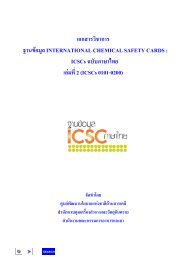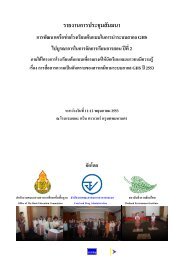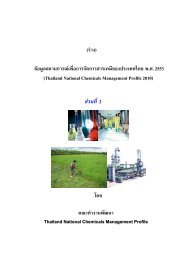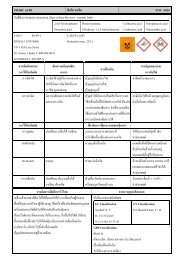Ortho-TOLUIDINE ICSC: 0341 - chemical safety section
Ortho-TOLUIDINE ICSC: 0341 - chemical safety section
Ortho-TOLUIDINE ICSC: 0341 - chemical safety section
Create successful ePaper yourself
Turn your PDF publications into a flip-book with our unique Google optimized e-Paper software.
ortho-<strong>TOLUIDINE</strong> <strong>ICSC</strong>: <strong>0341</strong><br />
Date of Peer Review: March 1995<br />
1-Amino-2-methylbenzene<br />
2-Aminotoluene<br />
o-Methylaniline<br />
CAS # 95-53-4 C7H9N / C6H4CH3NH2<br />
RTECS # XU2975000 Molecular mass: 107.2<br />
UN # 1708<br />
EC Annex 1 Index # 612-091-00-X<br />
EC/EINECS # 202-429-0<br />
TYPES OF HAZARD /<br />
EXPOSURE<br />
FIRE<br />
EXPLOSION<br />
EXPOSURE<br />
ACUTE HAZARDS /<br />
SYMPTOMS<br />
Combustible. Gives off irritating<br />
or toxic fumes (or gases) in a fire.<br />
Above 85°C explosive vapour/air<br />
mixtures may be formed.<br />
Inhalation Blue lips or finger nails. Blue skin.<br />
Confusion. Dizziness. Headache.<br />
Shortness of breath. Weakness.<br />
Skin MAY BE ABSORBED! Redness.<br />
Blue lips or fingernails. Blue skin.<br />
(Further see Inhalation).<br />
PREVENTION<br />
NO open flames. NO contact with<br />
nitric acid.<br />
Above 85°C use a closed system,<br />
ventilation.<br />
FIRST AID / FIRE<br />
FIGHTING<br />
Powder. Foam. Carbon dioxide.<br />
In case of fire: keep drums, etc.,<br />
cool by spraying with water.<br />
AVOID ALL CONTACT! IN ALL CASES CONSULT A<br />
DOCTOR!<br />
Ventilation, local exhaust, or<br />
breathing protection.<br />
Protective gloves. Protective<br />
clothing.<br />
Fresh air, rest. Artificial<br />
respiration may be needed. Refer<br />
for medical attention.<br />
Remove contaminated clothes.<br />
Rinse and then wash skin with<br />
water and soap. Refer for medical<br />
attention.<br />
Eyes Redness. Pain. Safety goggles. First rinse with plenty of water for<br />
several minutes (remove contact<br />
lenses if easily possible), then<br />
take to a doctor.<br />
Ingestion Blue lips or fingernails. Blue skin.<br />
Dizziness. Headache. Laboured<br />
breathing. (Further see<br />
Inhalation).<br />
Do not eat, drink, or smoke<br />
during work.<br />
SPILLAGE DISPOSAL PACKAGING & LABELLING<br />
Collect leaking and spilled liquid in sealable containers as far as<br />
possible. Absorb remaining liquid in sand or inert absorbent and<br />
remove to safe place. Personal protection: complete protective<br />
clothing including self-contained breathing apparatus.<br />
EMERGENCY RESPONSE STORAGE<br />
Transport Emergency Card: TEC (R)-61GT1-II<br />
NFPA Code: H3; F2; R0<br />
IPCS<br />
International<br />
Programme on<br />
Chemical Safety<br />
Do not transport with food and feedstuffs. Note: E<br />
EU Classification<br />
Symbol: T, N<br />
R: 45-23/25-36-50<br />
S: 53-45-61<br />
UN Classification<br />
UN Hazard Class: 6.1<br />
UN Pack Group: II<br />
Rinse mouth. Induce vomiting<br />
(ONLY IN CONSCIOUS<br />
PERSONS!). Refer for medical<br />
attention.<br />
Separated from strong oxidants, strong acids, food and feedstuffs.<br />
Cool. Dry. Well closed. Ventilation along the floor.<br />
Prepared in the context of cooperation between the International<br />
Programme on Chemical Safety and the Commission of the<br />
European Communities © IPCS, CEC 2005<br />
SEE IMPORTANT INFORMATION ON BACK
ortho-<strong>TOLUIDINE</strong> <strong>ICSC</strong>: <strong>0341</strong><br />
PHYSICAL STATE; APPEARANCE:<br />
COLOURLESS TO YELLOW LIQUID, TURNS REDDISH-BROWN<br />
ON EXPOSURE TO AIR AND LIGHT.<br />
CHEMICAL DANGERS:<br />
The substance decomposes on heating or on burning producing toxic<br />
fumes including nitrogen oxides. Reacts with strong oxidants,<br />
especially nitric acid.<br />
OCCUPATIONAL EXPOSURE LIMITS:<br />
TLV: 2 ppm as TWA; (skin); A3 (confirmed animal carcinogen with<br />
unknown relevance to humans); BEI issued; (ACGIH 2004).<br />
MAK: skin absorption (H); Carcinogen category: 1; Germ cell mutagen<br />
group: 3A (DFG 2006).<br />
Boiling point: 200°C<br />
Melting point: -16°C<br />
Relative density (water = 1): 1.01<br />
Solubility in water: poor<br />
Vapour pressure, kPa at 20°C: 0.2<br />
Relative vapour density (air = 1): 3.7<br />
The substance is harmful to aquatic organisms.<br />
IMPORTANT DATA<br />
PHYSICAL PROPERTIES<br />
ENVIRONMENTAL DATA<br />
NOTES<br />
ROUTES OF EXPOSURE:<br />
The substance can be absorbed into the body by inhalation and<br />
through the skin and by ingestion.<br />
INHALATION RISK:<br />
Evaporation at 20°C is negligible; a harmful concentration of airborne<br />
particles can, however, be reached quickly on spraying.<br />
EFFECTS OF SHORT-TERM EXPOSURE:<br />
The substance irritates the eyes and the skin. The substance may<br />
cause effects on the blood, bladder and kidneys , resulting in tissue<br />
lesions, impaired functions and formation of methaemoglobin.<br />
Exposure to high concentrations may result in damage to kidneys and<br />
bladder. The effects may be delayed. Medical observation is<br />
indicated. See Notes.<br />
EFFECTS OF LONG-TERM OR REPEATED EXPOSURE:<br />
The substance may have effects on the blood , resulting in formation<br />
of methaemoglobin (see Notes). This substance is possibly<br />
carcinogenic to humans.<br />
Relative density of the vapour/air-mixture at 20°C (air = 1): 1.00<br />
Flash point: 85°C c.c.<br />
Auto-ignition temperature: 482°C<br />
Explosive limits, vol% in air: 1.5-?<br />
Octanol/water partition coefficient as log Pow: 1.32<br />
Depending on the degree of exposure, periodic medical examination is suggested. Specific treatment is necessary in case of poisoning with<br />
this substance; the appropriate means with instructions must be available. The odour warning when the exposure limit value is exceeded is<br />
insufficient. Also consult <strong>ICSC</strong> # 0342, meta-Toluidine and 0343, para-Toluidine. Card has been partly updated in October 2005. See <strong>section</strong>s<br />
Occupational Exposure Limits, EU classification, Emergency Response. Card has been partly updated in October 2006. See <strong>section</strong>s<br />
Occupational Exposure Limits.Card has been partially updated in January 2008: see Fire fighting.<br />
ADDITIONAL INFORMATION<br />
LEGAL NOTICE Neither the CEC nor the IPCS nor any person acting on behalf of the CEC or the IPCS is responsible for the use<br />
which might be made of this information<br />
See Also:<br />
Toxicological Abbreviations<br />
© IPCS, CEC 2005








